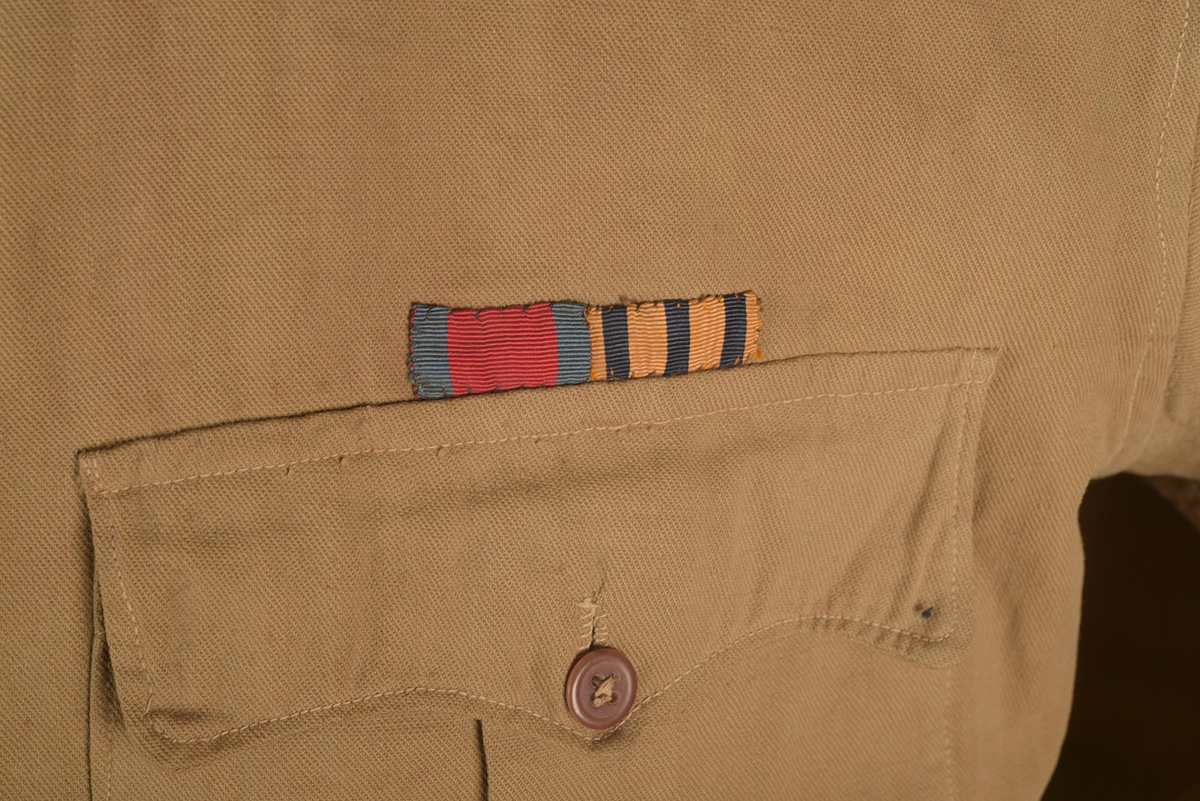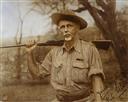Product Details
BY TRADITION, FORMERLY THE PROPERTY OF FREDERICK COURTENEY SELOUS D.S.O.
A GREEN FELT SLOUCH HAT AND A HALF-FRONT SAFARI SHIRT,
the slouch hat with plain green band, leather inner band gold embossed in gold 'Manufactured expressly for Cearn's Nairobi' and with a size label of 6 3/4, some light mothing;
the half front shirt unlabelled, the epaulettes each with a Captain's three bronze 'Tria Juncta In Uno' pips (some missing retaining pins), ribbons for the DSO and BSAC above the left pocket, some light staining.
Provenance: The vendor has kindly supplied us with the following information regarding the provenance of these pieces - and has kindly agreed that he will be happy to communicate with the buyer of the Lot to discuss the history further:
"As promised here are few notes on the provenance of Captain Frederick Courteney Selous's bush hat & military bush shirt entrusted to me by my mother when I was a soldier in the Household Cavalry in 1965.
These two historic items came into my family's possession because of my grandfather, The sculptor William Robert Colton RA (Professor at the Royal Academy, President of the Royal British Society of Sculptors, and full member at the Royal Academy (25 December 1867 - 13 November 1921).
Captain Selous sat for Colton in his Kensington studio in London. The evidence for this is the magnificent memorial of Selous in the Natural History Museum in London SW7 wearing the very same bush shirt and hat that I possess. The memorial tablet dedicated to Captain Selous DSO is positioned at the head of the northwest staircase in the Central Hall of the Natural History Museum, London. The figure and plaque are in bronze, and the tablet is in stone. The memorial consists of a cast bronze portrait of Captain Selous in uniform and carrying a rifle. This is set into a niche in the stone tablet. Below the niche is a bronze relief of lions. The inscriptions are arranged in two side panels in raised block lettering. The sculptor's name is placed at the bottom right. The inscription on the left panel reads Caption Frederick C. Selous D.S.O. Hunter Explorer and Naturalist. On the right panel Born 1851 Killed in action at Beho-Beho German East Africa 4 1 1917.. Selous was buried in East Africa in what is now Tanzania.
When Selous was being sculpted by Colton he gave the shirt and hat to him as a present. My mother Nora Law (nee Colton) the daughter of Colton subsequently inherited these items on Colton's premature death in 1921 aged 53.
Over the years I have been trying to find a home for these two historic possessions.
Other Notable South African work by William Robert Colton Included:
- Worcester Boer War Memorial
- Royal Artillery Boer War Memorial "
Exhibited: William Robert Colton's bronze bust (dated at 1919 by the Royal Society of Sculptors), depicting Selous in his trademark hat and shirt was unveiled at the Natural History Museum on 10th June 1920
Literature: William Robert Colton (1867 - 1921)
Born in Paris, Colton studied sculpture at the Lambeth School of Art and entered the Royal Academy Schools in 1889 (simultaneously continuing his studies in Paris). He commenced his career as a sculptor at the age of 20 and within two years was exhibiting at both the Paris Salon and the Royal Academy.
His sculpture The Girdle, shown at the RA in 1898 was bought by The Chantrey Fund trustees (The sculptor Sir Francis Chantrey RA (1781-1841) bequeathed a fortune, and asked that the income on the money be used to buy paintings and sculpture made in Britain with a view to encouraging the establishment of a public national collection of British fine art. The fund is administered by the Royal Academy of Arts, and the first work was bought for the collection in 1877, following the death of Lady Chantrey. After the founding of the Tate Gallery in 1897 the Bequest was allocated to support Tate acquisitions. Until the 1920s this was the main purchase grant for the Tate Gallery) and can still be seen at Tate Britain.
He received a series of private commissions from the Maharajah of Mysore and throughout his career, private commissions from India, South Africa, Australia and South Africa would significantly bolster his domestic work.
In the period 1905 to 1920, Colton exhibited regularly at the Royal Academy and among his bronze busts shown there were: HH The Maharajah of Mysore (1905); Sir Sheshadri Iyer, Dewan of Mysore (1907); Field Marshal Earl Roberts (1915); Lieutenant Colonel Sir George Roos Keppel (1916); Marjorie Brassey (1917); and Diana (1917)
His war memorial commissions include the Memorial to Sir Richard and George Tangye (1916) in Birmingham City Art Gallery and a bronze Memorial to Boyd and Claud Alexander in Cranbrook Parish Church. In 1908 Colton sculpted the Worcester Boer War Memorial and he was also responsible for the Royal Artillery Boer War Memorial on the corner of St James's Park.
Colton was elected ARA in 1903 and served as Professor of Sculpture at the Royal Academy from 1907 to1911. In the period 1911 to 12 he was Visitor in Sculpture at the Royal College of Art and he went on to become a Royal Academician in 1919. He was also a Member of the Standing Committee of Advice for Education in Art; Board of Education and a Principal Examiner for the Board of Education in Modelling and Sculpture.
After a distinguished career as both sculptor and teacher, Colton died on 13 November 1921 at the relatively young age of 53. At the time of his death, he was serving as President of the Royal Society of Sculptors
Other Notes: Frederick Courtney Selous (1851 - 1917) needs little introduction, explorer, officer, professional hunter and conservationist, his interest in explorers and adventurers began in his early years. His hunting exploits began at the age of 19 in Matabeleland, when with the personal permission of Lobengala, King of the Ndebele to hunt his lands, he explored the little known regions north of the Transvaal and south of the Congo Basin, shooting and collecting specimens for all kinds of museums and private collections.
Having been convinced by Cecil Rhodes to join the British South Africa Company in 1890, he acted as a guide to the expedition to Mashonaland - and in 1892 was awarded the Founder's Medal of the Royal Geographical Society in recognition of his extensive explorations and surveys (the subject of his journal article '20 Years in Zambesia').
He took part in the First Matabele War in 1893 and was wounded in action in the advance on Bulawayo, prompting a return to England where he would marry the following year. Returning and settling in Matabeleland with his wife in 1896, at the outbreak of the Second Matabele War, he again took a prominent part in the fighting, serving as a leader in the Bulawayo Field Force (during which he fought alongside Robert Baden-Powell). In 1896, Queen Victoria sanctioned the issue of the British South Africa Company medal to troops who had served in the First Matebele War, extended the following year to those who served in the Rhodesia and Mashonaland campaigns of the Second Matabele War.
His hunting career spanned most continents between 1871 up to the Great War and led him to count the likes of Theodore Roosevelt amongst his friends. In 1902 he was elected Associate Member of the Boone and Crockett Club, a wildlife conservation organisation founded by Theodore Roosevelt and George Bird Grinnell. In 1909 he would set up his own endeavour, the Shikar Club (an association for big game hunters).
When the First World War broke out, having initially been rejected for service due to his age, he eventually managed to secure a post as a subaltern in the British Army and fought against the German colonial forces in the East Africa Campaign. In 1915 he was promoted to Captain in the 25th (Frontiersmen) Battalion, Royal Fusiliers. A most unusual unit, the 25th was made up of an eclectic mix of men, many of a more distinguished age like Selous himself and many veterans of the Boer War. It is recorded that amongst the mix there were several big game hunters, an opera singer, a Scottish lighthouse keeper, a British millionaire, a naturalist, a circus clown, and Arctic explorer, a photographer, a lion tamer and several American cowboys, together with a number of French Foreign Legionnaires.
He was awarded the DSO on 26th September 1916 'for conspicuous gallantry, resource and endurance' and for setting 'a magnificent example to all ranks, the value of his services with his battalion can not be over-estimated.'
On the 4th January 1917, whilst fighting in the bush war on the banks of the Rufiji River, his unit heavily outnumbered by his German counterparts, he was killed by a German sniper.
On hearing the news, Theodore Roosevelt wrote:
"He led a singularly adventurous and fascinating life, with just the right alternations between the wilderness and civilization. He helped spread the borders of his people's land. He added much to the sum of human knowledge and interest. He closed his life exactly as such a life ought to be closed, by dying in battle for his country while rendering her valiant and effective service. Who could wish a better life or a better death, or desire to leave a more honorable heritage to his family and his nation?"
Following his death, his private collection of trophies was donated to the Natural History Museum, over five thousand plant and animal specimens. A monument in stone and bronze dedicated to him was placed in the main hall of the Natural History museum in 1920 in recognition of his remarkable life and the significant 'Selous Collection' that formed such a big part of their inventory
Please click HERE to view Terms & Conditions. Please note all Lots are listed in accordance with UK Law, for overseas buyers, please ensure you are familiar with your relevant local firearms and customs regulations before bidding.
Estimate £1,000-1,500









